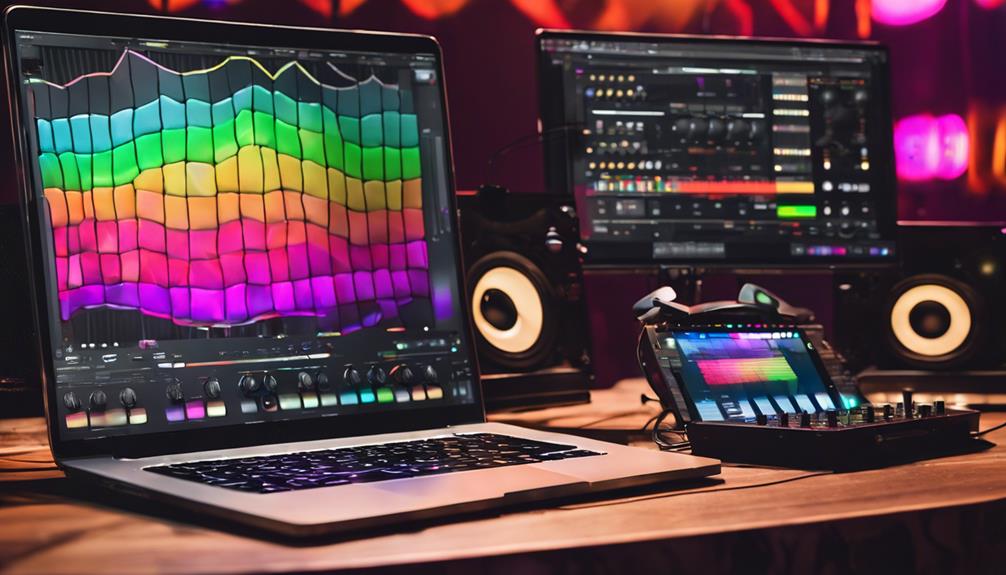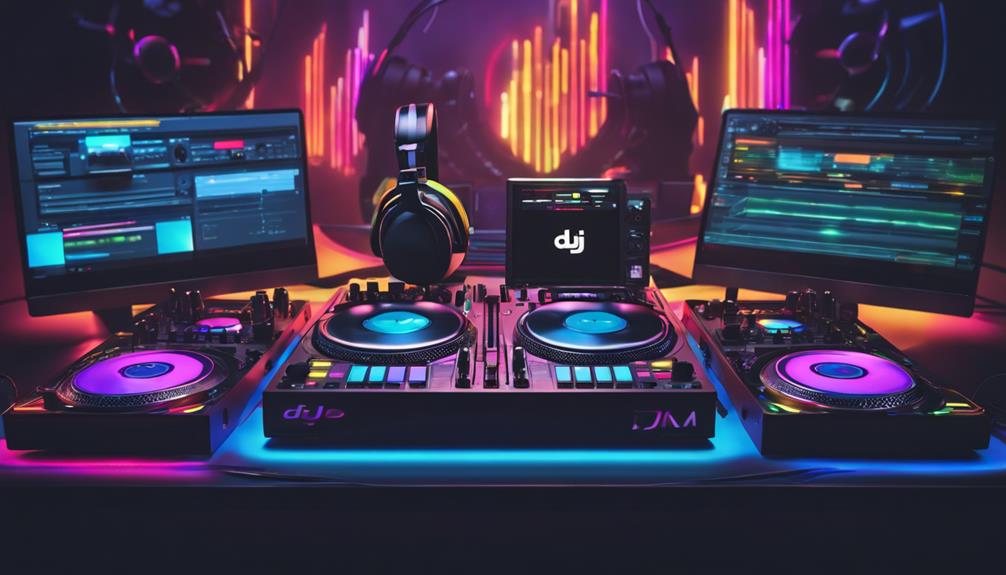No products in the cart.
To enhance DJ software effects, begin by selecting software with robust EQ, compression, and seamless hardware integration. Get acquainted with the interface, trying out sliders and knobs to adjust effects like reverb and delay to refine your audio output. Grasp the fundamentals of effects; utilize filters for dynamic sweeps and EQs for tonal balance. Immerse yourself in adjusting parameters like wet/dry mix in real-time, adding depth with modulation techniques. Explore mixing different effects to craft unique sound textures. Regularly practicing these techniques will greatly improve your mixes and boost your performance, revealing new dimensions in your DJing skills.
Key Takeaways
- Select DJ software that supports essential effects like EQ, filters, and delay, and ensures hardware compatibility.
- Familiarize yourself with the interface to effectively manipulate effect parameters like wet/dry mix and feedback.
- Understand and apply basic effects such as filters, EQ, and echo to enhance mix dynamics and texture.
- Experiment with layering multiple effects to create unique soundscapes and maintain clarity in mixes.
- Continuously practice adjusting effect intensity and combining different effects to master creative sound manipulation.
Selecting the Right Software
Selecting the appropriate DJ software depends on evaluating its mastering capabilities, such as EQ, compression, and limiting, to confirm it aligns with your specific requirements. You’ll want to make sure that the software not only offers advanced features but also supports seamless software integration and hardware compatibility. This is important because you need your software to work effortlessly with a range of DJ controllers and audio interfaces, which will greatly enhance your performance reliability and flexibility.
Moreover, while considering interface customization, you should look for software that allows you to tailor its layout and controls to suit your workflow. Workflow optimization is key in mastering DJ software. It enables you to streamline your process, making it faster and more intuitive. This means spending less time customizing the software and more time focusing on the creative aspects of your mix.
Exploring the Interface
Exploring the interface of your DJ software, you’ll encounter a control panel that allows for precise manipulation of various effects like reverb, delay, and flanger. This panel is your gateway to fully customizing how these effects interact with your tracks, shaping the sound to fit your unique style. You’ll notice sliders and knobs that adjust parameters such as intensity and timing, essential for fine-tuning the audio output.
As you venture further, you’ll uncover the presets section. Here, you can immerse yourself in a world of pre-configured settings, each tailored for different musical styles and venues. Exploring presets not only saves time but also introduces you to configurations you mightn’t have considered. They serve as a fantastic starting point for beginners and a quick setup option for seasoned professionals.
Customizing settings is where your creativity truly shines. Each effect within the interface can be adjusted individually, allowing you to layer multiple effects on a single track or apply them globally across all tracks. Experimenting with the depth of reverb, the echo of delay, or the sweep of flanger can transform a simple mix into a compelling auditory experience. This hands-on approach encourages innovative soundscapes, turning each performance into a unique event.
Understanding Basic Effects
After exploring the interface and presets, let’s focus on mastering basic effects like filters, EQs, and delays to enhance your DJ mixes. Understanding these foundational tools is vital as they form the bedrock for more complex sound manipulations and creative mixing.
Here are essential concepts to grasp:
- Filters: Manipulate the frequency content of a track by cutting or boosting specific ranges. This is your go-to for sculpting the sound and creating dynamic sweeps in your mix.
- EQs: Adjust the tonal balance of a track by modifying bass, mid, and treble frequencies. Use EQs to blend tracks seamlessly or to highlight specific elements in a song.
- Delays: Introduce echoes to your mix, setting the stage for rhythmic variations. Delays can be used subtly for texture or more prominently to define a new rhythm layer.
- Advanced Techniques: Start layering effects creatively and customizing effect chains for unique sound manipulation. This includes using advanced modulation techniques to evolve the sound dynamically during a performance.
Adjusting Effect Parameters
As you progress in using DJ software effects, understanding how to control parameters like wet/dry mix and feedback becomes essential.
You’ll need to adjust these settings in real-time, ensuring your effects blend seamlessly with live tracks.
Mastering the art of parameter adjustment not only enhances your mixes but also allows you to dynamically shape the soundscapes of your performances.
Understanding Parameter Controls
Why not start by mastering the art of adjusting effect parameters like wet/dry mix, feedback, and resonance to precisely control the intensity of your effects? Here’s how you can enhance your DJing skills:
- Advanced Modulation Techniques: Experiment with modulation rate and depth to add texture and movement to your tracks, enriching the vibrancy of each mix.
- Customizing Resonance Levels: Tweak resonance settings in filters to emphasize specific frequencies, crafting a signature sound that stands out.
- Creative Sound Manipulation: Utilize dynamic effect adjustments in reverb and delay to create atmospheric depth or rhythmic complexity.
- Dynamic Effect Adjustments: Adjust decay times and feedback loops to fine-tune how effects evolve over time, ensuring seamless integration with your musical elements.
Real-Time Parameter Adjustment
Building on your understanding of parameter controls, mastering real-time adjustment of these settings is key to enhancing your live DJ performances. This skill allows you to tweak effect parameters like depth, speed, intensity, and resonance on the fly, dynamically matching the energy and vibe of the tracks you’re spinning.
Such flexibility is essential, not just for maintaining momentum but also for injecting your personal touch into every mix. By adjusting these parameters in real time, you open up a world of creative adjustments, making each performance unique.
Mastering this technique guarantees that you can captivate your audience with seamless, engaging sequences that resonate with the atmosphere of the moment, truly elevating the live performance experience.
Utilizing Filters Effectively
To enhance your DJ sets, learn to manipulate track frequencies effectively by using different types of filters, such as low-pass, high-pass, band-pass, and notch. Filters allow you to shape the sound in real-time, giving your mixes a dynamic and textured feel.
Here’s how you can refine your mixing skills through effective filter use:
- Filter Modulation Techniques: Experiment with automating the filter cutoff to create sweeping effects that move with your track’s rhythm. This dynamic change in frequency can significantly alter the energy and mood within your set.
- Advanced Filter Manipulation: Develop proficiency in manipulating the resonance and slope settings of your filters. Increasing resonance can add a noticeable peak around the cutoff frequency, which highlights changes or emphasizes particular musical elements.
- Creative Filter Applications: Use filters to isolate certain frequencies and layer tracks more cohesively. By blending only specific parts of the frequency spectrum, you can create unique sound textures and smooth overlaps between songs.
- Filter Blending Techniques: Skillfully combine high-pass and low-pass filters to perform frequency-based cuts. This technique is invaluable in crafting seamless mixes that maintain energy flow without overwhelming your audience with too much bass or treble.
Master these techniques to add sophistication and professional polish to your DJ performances.
Mastering Echo Techniques
As you explore mastering echo techniques, consider varying the echo time to tailor the sound dynamics to your track.
By layering multiple echoes, you can create complex, textured soundscapes that enhance the auditory experience.
Adjusting these parameters with precision guarantees your echoes complement rather than overwhelm the original mix.
Echo Time Variations
Mastering echo techniques involves adjusting the echo time variations to create rhythmic patterns and textures that enhance the depth and movement of your mix. By tweaking these settings, you can manipulate the spatial aspects of sound, making each track uniquely engaging.
Here’s how you can master echo time variations:
- Echo Modulation: Adjust the modulation depth and rate to vary the echo effect dynamically, making it breathe with your music.
- Tempo Synchronization: Sync the echo delay to your track’s BPM, ensuring rhythmic consistency.
- Short vs. Long Delays: Use shorter delays for subtle effects and longer delays to create a more pronounced echo.
- Feedback Control: Manage feedback amount to either intensify the echo or keep it under control.
Experiment within these parameters to discover your distinct sound.
Layering Multiple Echoes
Building on your understanding of echo time variations, you’ll discover that layering multiple echoes opens up new dimensions of depth and complexity in your tracks. By adjusting the delay time, feedback, and filtering of each echo layer, you can create a tailored sound environment.
Immerse yourself in echo modulation to dynamically alter the sonic characteristics, adding a pulsating effect to the echoes. Employ creative delay techniques by combining different echo types, such as tape echo with digital delay, and integrating reverb for added ambiance. This not only enhances the overall sound but also injects texture and rhythmic interest.
Be meticulous with the echo levels and timing to make sure the mix remains clear and not overwhelmed.
Experimenting With Flangers
Explore the dynamic capabilities of flangers to enhance your tracks with a unique, swirling sound by adjusting key parameters like feedback and rate. Flanger modulation is crucial for achieving that sought-after whooshing effect that can make your music stand out. Understanding how to manipulate these settings allows for innovative applications that can enrich your soundscapes.
Here’s how you can start experimenting with flangers:
- Adjust Feedback: Increase the feedback to intensify the repeating effect. Higher feedback will produce a more pronounced flanging sound, adding a dramatic flair to any track.
- Modify Depth: Depth controls how much the delay time varies. Playing with this parameter lets you go from subtle waves to deep, transformative sounds that can redefine the mood of your mix.
- Change Rate: The rate determines the speed of the modulation cycle. Altering the rate can shift the sound from slow, gentle sweeps to rapid oscillations, providing a spectrum of rhythmic possibilities.
- Tweak Resonance: Resonance amplifies the effect at certain frequencies. Adjust this to highlight specific elements of the flanger, tailoring the effect to fit perfectly within your tracks.
Layering Multiple Effects
Layering multiple effects in your DJ software frequently allows you to create a more textured and nuanced sonic landscape. By mastering effect blending techniques, you’ll reveal endless possibilities for creative sound manipulation. For instance, combining a subtle reverb with a synchronized delay can add both space and rhythm to your tracks, enhancing the listening experience without cluttering the mix.
When you explore texture layering, consider the role of each effect. A high-pass filter might clean up the lows, letting a shimmering flanger shine through without muddying the sound. Timing these effects correctly is essential; they should complement each other rather than compete. This approach not only maintains clarity but also enriches the textures of your mix.
Dynamic progressions are another powerful aspect of effect layering. By tweaking the parameters of overlapping effects, you can create a build-up that captivates your audience, then smoothly shift into a different sonic chapter. This isn’t just about changing tracks—it’s about storytelling through sound. Experiment with different combinations to discover how even subtle shifts in effect settings can significantly alter the vibe of your set, keeping your audience engaged and on their toes.
Controlling Effect Intensity
As you explore the art of controlling effect intensity in DJ software, understanding how to adjust the wet/dry mix is essential. By finely tuning this parameter, you can enhance the subtlety or prominence of effects, seamlessly integrating them into your tracks.
Additionally, automating effect changes can greatly enhance your performance, allowing for dynamic shifts and maintaining the energy flow throughout your set.
Adjusting Wet/Dry Mix
To master your DJ mixes, you’ll need to skillfully adjust the wet/dry mix, balancing the original audio with the intensity of applied effects. Here’s how you can refine your control over the wet/dry balance, ensuring effect subtlety and peak audio blending:
- Start with Low Wetness: Begin at a lower wet setting and gradually increase it to add the desired effect intensity without overwhelming the track.
- Listen Carefully: Pay close attention to how the effect meshes with the dry signal. Adjust until you achieve a harmonious blend.
- Use High-Quality Effects: Higher quality effects often provide better control over their intensity, making subtle adjustments easier.
- Practice Regularly: The more you experiment with different settings, the better you’ll understand the impact of subtle changes on your overall mix.
Automating Effect Transitions
Building on your mastery of the wet/dry mix, automating effect shifts allows you to enhance the intensity of effects for dynamic and engaging mixes. By mastering effect automation techniques, you can execute smooth intensity adjustments that elevate the flow of your set. These adjustments aren’t just about changing levels; they’re about crafting creative shifts that captivate your audience.
Software tools are essential here, providing you with precise control over each parameter, enabling seamless automation. This capability lets you build up or dial down effects gradually, leading to dynamic builds and dramatic drops. The polished, professional quality this adds can’t be exaggerated.
Dive deep into these techniques to open up a new dimension of creativity and depth in your performances.
Recording and Playback Tips
Make sure you optimize your recording levels to avoid clipping and distortion during playback. This is fundamental in maintaining high audio fidelity, a critical aspect of professional DJing. Here’s how you can enhance your recording techniques and playback optimization:
- Choose High-Quality Equipment: Always use premium audio interfaces and cables. High-quality gear guarantees the integrity of your sound from the source to the speakers, reducing the risk of errors that might degrade your audio during critical live performances.
- Set Proper Recording Parameters: Configure your software to record at the best sample rate and bit depth. This setting guarantees that you capture the best possible sound quality, which is essential for both mixing and playback.
- Monitor Precisely: Utilize studio monitors or high-fidelity headphones for monitoring. This practice allows you to hear exactly what’s being recorded or played back with no coloration, ensuring your tracks sound as intended on any system.
- Use Software Monitoring Features: Engage software tools to monitor input levels and make real-time adjustments. This dual-viewing capability helps in making instant tweaks, thereby enhancing the overall quality of your output.
Keep these points in mind to ensure your tracks aren’t just heard, but felt.
Practicing for Live Performances
As you prepare for live performances, mastering shifts and effects in your DJ software is vital for guaranteeing your sets flow seamlessly. Delve deep into practicing changes, utilizing your hot cues and loop controls to keep your mixes engaging. These elements not only guarantee a smooth performance but also enhance your interaction with the crowd, keeping the performance energy high.
Experiment vigorously with software effects like filters and reverbs. These tools can add a remarkable depth to your sound, transforming an ordinary track into a mesmerizing experience for your audience. This innovation in your mixes contributes greatly to maintaining and amplifying the crowd’s energy.
Don’t overlook the power of the sync function to maintain a consistent tempo across tracks. This feature is essential for avoiding timing errors that can disrupt the flow of your set. Additionally, practice live remixing and creating mashups. Utilizing effects and samples skillfully can lead to a dynamic performance, making your set not only a listening experience but an interactive event. Engage your audience with these creative mixes, ensuring your performance is memorable and energetically charged.
Frequently Asked Questions
What Are the Basic Steps of Mastering?
You’ll start mastering by adjusting EQ settings to balance frequencies, then apply compression techniques to even out dynamics. Follow with limiting to prevent clipping, and finalize with volume adjustments for best playback.
How to DJ Step by Step?
To DJ step by step, start with equipment setup, then learn beat matching. Practice using your gear, mix tracks smoothly, and progressively incorporate more complex techniques to enhance your performance.
What Are the Stages of Audio Mastering?
In audio mastering, you’ll first equalize, then apply dynamic range compression to smooth volume levels. Next, use limiting to boost volume without distortion, and finish with stereo enhancement to refine spatial attributes.
How Does Mastering Software Work?
Mastering software uses algorithm optimization and feature integration to enhance audio tracks. You’ll adjust EQ, compression, and limiting to meet industry standards, achieving a polished, professional sound ready for distribution.
Conclusion
Now that you’ve explored the essentials of DJ software effects, remember the key is in the details. Adjust your effects’ parameters finely and experiment with layering to create innovative sounds.
Use filters with precision and control the intensity to match the energy of your track. Practice both recording setups and live scenarios to perfect your skills.
Keep pushing the boundaries of what’s possible, and soon, you’ll master the art of DJing with a professional edge.




